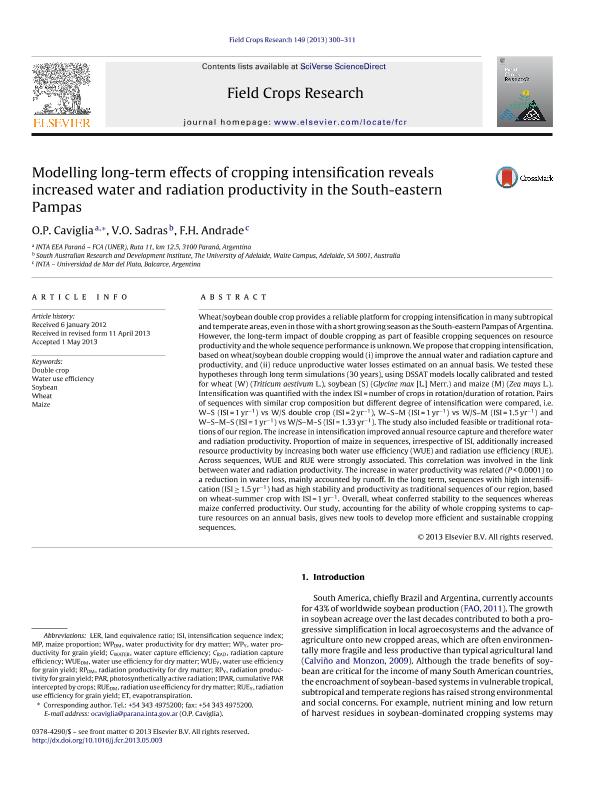Mostrar el registro sencillo del ítem
dc.contributor.author
Caviglia, Octavio Pedro

dc.contributor.author
Sadras, Victor Oscar

dc.contributor.author
Andrade, Fernando Héctor

dc.date.available
2016-01-05T19:57:02Z
dc.date.issued
2013-08-01
dc.identifier.citation
Caviglia, Octavio Pedro; Sadras, Victor Oscar; Andrade, Fernando Héctor; Modelling long-term effects of cropping intensification reveals increased water and radiation productivity in the south-eastern Pampas; Elsevier; Field Crops Research; 149; 1-8-2013; 300-311
dc.identifier.issn
0378-4290
dc.identifier.uri
http://hdl.handle.net/11336/3356
dc.description.abstract
Wheat/soybean double crop provides a reliable platform for cropping intensification in many subtropical and temperate areas, even in those with a short growing season as the South-eastern Pampas ofArgentina. However, the long-term impact of double cropping as part of feasible cropping sequences on resource productivity and the whole sequence performance is unknown.We propose that cropping intensification, based on wheat/soybean double cropping would (i) improve the annual water and radiation capture and productivity, and (ii) reduce unproductive water losses estimated on an annual basis. We tested these hypotheses through long term simulations (30 years), using DSSAT models locally calibrated and tested for wheat (W) (Triticum aestivum L.), soybean (S) (Glycine max [L.] Merr.) and maize (M) (Zea mays L.). Intensification was quantified with the index ISI = number of crops in rotation/duration of rotation. Pairs of sequences with similar crop composition but different degree of intensification were compared, i.e. W–S (ISI = 1 yr−1) vs W/S double crop (ISI = 2 yr−1), W–S–M (ISI = 1 yr−1) vs W/S–M (ISI = 1.5 yr−1) and W–S–M–S (ISI = 1 yr−1) vs W/S–M–S (ISI = 1.33 yr−1). The study also included feasible or traditional rotations of our region. The increase in intensification improved annual resource capture and therefore water and radiation productivity. Proportion of maize in sequences, irrespective of ISI, additionally increased resource productivity by increasing both water use efficiency (WUE) and radiation use efficiency (RUE). Across sequences, WUE and RUE were strongly associated. This correlation was involved in the link between water and radiation productivity. The increase in water productivity was related (P < 0.0001) to a reduction in water loss, mainly accounted by runoff. In the long term, sequences with high intensifi- cation (ISI ≥ 1.5 yr−1) had as high stability and productivity as traditional sequences of our region, based on wheat-summer crop with ISI = 1 yr−1. Overall, wheat conferred stability to the sequences whereas maize conferred productivity. Our study, accounting for the ability of whole cropping systems to capture resources on an annual basis, gives new tools to develop more efficient and sustainable cropping sequences.
dc.format
application/pdf
dc.language.iso
eng
dc.publisher
Elsevier

dc.rights
info:eu-repo/semantics/openAccess
dc.rights.uri
https://creativecommons.org/licenses/by-nc-nd/2.5/ar/
dc.subject
Modelling
dc.subject
Crop Intensification
dc.subject
Double Crop
dc.subject
Maize
dc.subject
Wheat
dc.subject
Soybean
dc.subject
Water Use Efficiency
dc.subject.classification
Agronomía, reproducción y protección de plantas

dc.subject.classification
Agricultura, Silvicultura y Pesca

dc.subject.classification
CIENCIAS AGRÍCOLAS

dc.title
Modelling long-term effects of cropping intensification reveals increased water and radiation productivity in the south-eastern Pampas
dc.type
info:eu-repo/semantics/article
dc.type
info:ar-repo/semantics/artículo
dc.type
info:eu-repo/semantics/publishedVersion
dc.date.updated
2016-03-30 10:35:44.97925-03
dc.journal.volume
149
dc.journal.pagination
300-311
dc.journal.pais
Países Bajos

dc.journal.ciudad
Amsterdam
dc.description.fil
Fil: Caviglia, Octavio Pedro. Instituto Nacional de Tecnología Agropecuaria. Centro Regional Entre Ríos. Estación Experimental Agropecuaria Paraná; Argentina. Universidad Nacional de Entre Ríos; Argentina. Consejo Nacional de Investigaciones Científicas y Técnicas; Argentina
dc.description.fil
Fil: Sadras, Victor Oscar. Consejo Nacional de Investigaciones Científicas y Técnicas. Centro Científico Tecnológico Mar del Plata; Argentina. University of Adelaide; Australia
dc.description.fil
Fil: Andrade, Fernando Héctor. Consejo Nacional de Investigaciones Científicas y Técnicas. Centro Científico Tecnológico Mar del Plata; Argentina. Instituto Nacional de Tecnología Agropecuaria; Argentina. Universidad Nacional de Mar del Plata. Facultad de Ciencias Agrarias; Argentina
dc.journal.title
Field Crops Research

dc.relation.alternativeid
info:eu-repo/semantics/altIdentifier/url/http://www.sciencedirect.com/science/article/pii/S0378429013001755
dc.relation.alternativeid
info:eu-repo/semantics/altIdentifier/doi/http://dx.doi.org/10.1016/j.fcr.2013.05.003
Archivos asociados
